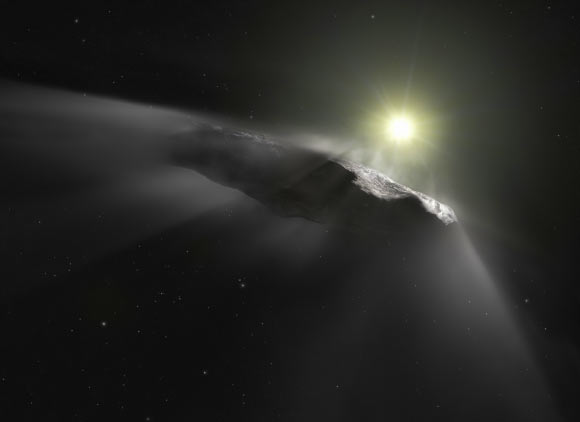Oumuamua is Interstellar Comet with Odd Properties, Astronomers Say | Astronomy – Sci-News.com
‘Oumuamua, a recently discovered object of extrasolar origin, is a comet that rocks, according to a new study by astronomers at Yale University and Caltech.

This artist’s impression shows ‘Oumuamua, the first interstellar object discovered in our Solar System. Recent observations show that the object is moving faster than predicted while leaving the Solar System. Astronomers assume that venting material from its surface due to solar heating is responsible for this behavior. This outgassing can be seen in this artist’s impression as a subtle cloud being ejected from the side of the object facing the Sun. Image credit: NASA / ESA / Hubble / ESO / M. Kornmesser.
Also known as 1I/2017 U1, ‘Oumuamua was first detected by the University of Hawaii’s Pan-STARRS 1 telescope on Haleakala, Hawaii, on October 19, 2017, more than a month after it passed its closest point to the Sun.
Subsequent detailed observations conducted by multiple ground-based telescopes and the NASA/ESA Hubble Space Telescope detected the sunlight reflected off the object’s surface.
Large variations in its brightness suggested that ‘Oumuamua is highly elongated and between 320 and 2,600 feet (100-800 m) in its longest dimension.
The object also experienced a small but persistent acceleration that could not be explained simply by the Sun’s gravitational pull.
Theories about its origin include everything from being a planetary fragment to an alien light probe.
“It has left a number of mysteries in its wake,” said study first author Darryl Seligman, a graduate student at Yale University.
“The reason for ‘Oumuamua’s acceleration is fairly mundane: it’s the venting of gas that was heated up by the Sun.”
“Such ‘outgassing’ happens regularly for comets. As a comet approaches the Sun and heats up, its ice erupts in a jet. Comet tails are formed when dust particles get caught in the jet and reflect sunlight.”
Yet ‘Oumuamua shows no evidence of a tail. Not only that, but ‘Oumuamua also doesn’t display the telltale spin that would be caused by a gas jet.
“In the model we’re proposing for ‘Oumuamua, the venting gas does not erupt from a single fixed point on the surface,” Laughlin said.
“Instead, the jets migrate along the surface, following the warmth and tracking the direction to the Sun.”
“This would mean that instead of spinning up, as in a typical comet, ‘Oumuamua rocks back and forth like a pendulum.”
At this point, ‘Oumuamua has passed beyond Saturn’s orbit; it will take more than 10,000 years for it to exit the Solar System entirely.
“Its discovery suggests that nearly every star in the Milky Way Galaxy may eject such objects during the planet formation process,” the scientists said.
The study will be published in the Astrophysical Journal Letters.
_____
Darryl Seligman et al. 2019. On the Anomalous Acceleration of 1I/2017 U1 ‘Oumuamua. ApJL, in press; arXiv: 1903.04723





